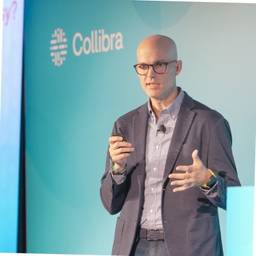End-to-end data visibility for Collibra Platform self-hosted customers with Collibra Data Lineage

Gartner predicts that government organizations will outspend all other industries on AI by the end of 2025.
Government and public sector organizations are investing in AI and analytics to enhance citizen experiences, improve operational efficiency, manage risks and achieve better mission outcomes. To succeed, they need clear visibility into the origin of data, transformations, quality and usage. This visibility builds confidence in AI and analytics, supports risk management and ensures compliance with regulatory requirements.
What’s new: Collibra Data Lineage for Collibra Platform Self-Hosted deployments
Collibra Data Lineage for Collibra Platform Self-Hosted deployments offers technical data lineage functionality for air-gapped environments, which are often required by US federal agencies or other highly regulated organizations for security purposes. A detailed lineage diagram tracks data as it moves through sources, systems and processes within an organization. It captures technical details of data flow, such as its origin, transformations and destinations, along with the underlying code, scripts and configurations that govern these movements. Technical data lineage provides a granular view of data processing, helping organizations ensure data accuracy, troubleshoot issues and comply with regulatory requirements.
How Collibra Data Lineage helps
Data Lineage supports impact analysis and change management by identifying dependencies before cutover, reducing risks during system modernization, and mapping upstream and downstream effects to accelerate incident response.
For data quality management, data lineage traces anomalies to their source for faster resolution and proactively notifies stakeholders impacted downstream.
In AI development and governance, data lineage connects inputs and training data to outputs, ensuring explainability, reproducibility and consistent results through versioned pipelines.
For regulatory compliance and auditing, data lineage demonstrates end-to-end data provenance for Freedom of Information Act (FOIA) requests, provides evidence of controls for auditability and maps PII flows to support privacy governance.
Data lineage increases data consumers' trust in reports and API endpoints that access information as part of business processes. It also enhances confidence in the data used by reports and API endpoints.
Problems it solves
- Inability to trace data flow: You cannot track data from its original source through transformations to each report or model, leading to blind spots and potential disputes.
- Difficulty developing and governing AI: Incomplete data lineage and limited visibility of controls create challenges in ensuring reliable, traceable and governed data for AI.
- Unclear change impact: You lack forward and backward impact analysis, making it difficult to predict the consequences of changes to sources, schemas or rules.
- Difficulty identifying data quality issues: Teams spend excessive time manually locating and resolving errors and discrepancies in reports.
- Oversight readiness gaps: Incomplete end-to-end data provenance and insufficient evidence of controls result in slow, manual audits, delayed FOIA responses and challenges with open-data releases.
- Low decision confidence: Stakeholders hesitate to make decisions due to unclear data origins, missing transformations and unknown freshness of data.
How Collibra Data Lineage works
The data lineage workflow consists of three phases: ingestion, analysis and synchronization.
- Ingest: Manage connections to your data sources, Business Intelligence (BI) tools, Extract, Transform, and Load (ETL) tools, and data catalogs through Collibra Edge. Your Collibra Edge site extracts metadata and transformations from these connections and delivers it to the Data Lineage service.
- Analyze: The Data Lineage service parses metadata and transformations to identify lineage assets, relations and associate them with incoming and outgoing transformation code.
- Synchronize: The Data Lineage service merges the metadata and lineage relations extracted from multiple lineage jobs into a single end-to-end lineage graph. Newly discovered assets and relations are published to the Collibra Data Catalog. Stitching then creates relations between technical lineage data objects and corresponding assets in the Data Catalog, providing a complete business catalog view of your data landscape and critical metadata.
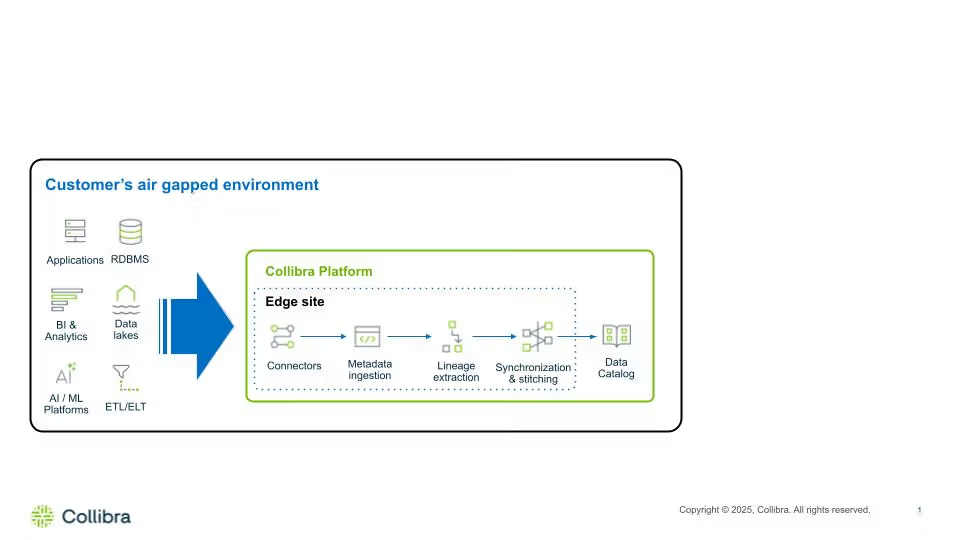
Data lineage workflow
You can visualize data lineage in the Collibra Platform through the Data Catalog interface. On an asset page, you can select the Diagram tab to open a business oriented view of data lineage. Diagrams allow you to see assets and their relations with business context. Diagram views are customizable queries that determine which nodes and edges are shown and how they are displayed in a diagram for specific assets. You can create multiple diagram views for the same asset type to tailor how the data is represented for different use cases, such as focusing on trusted business reporting or regulatory compliance.
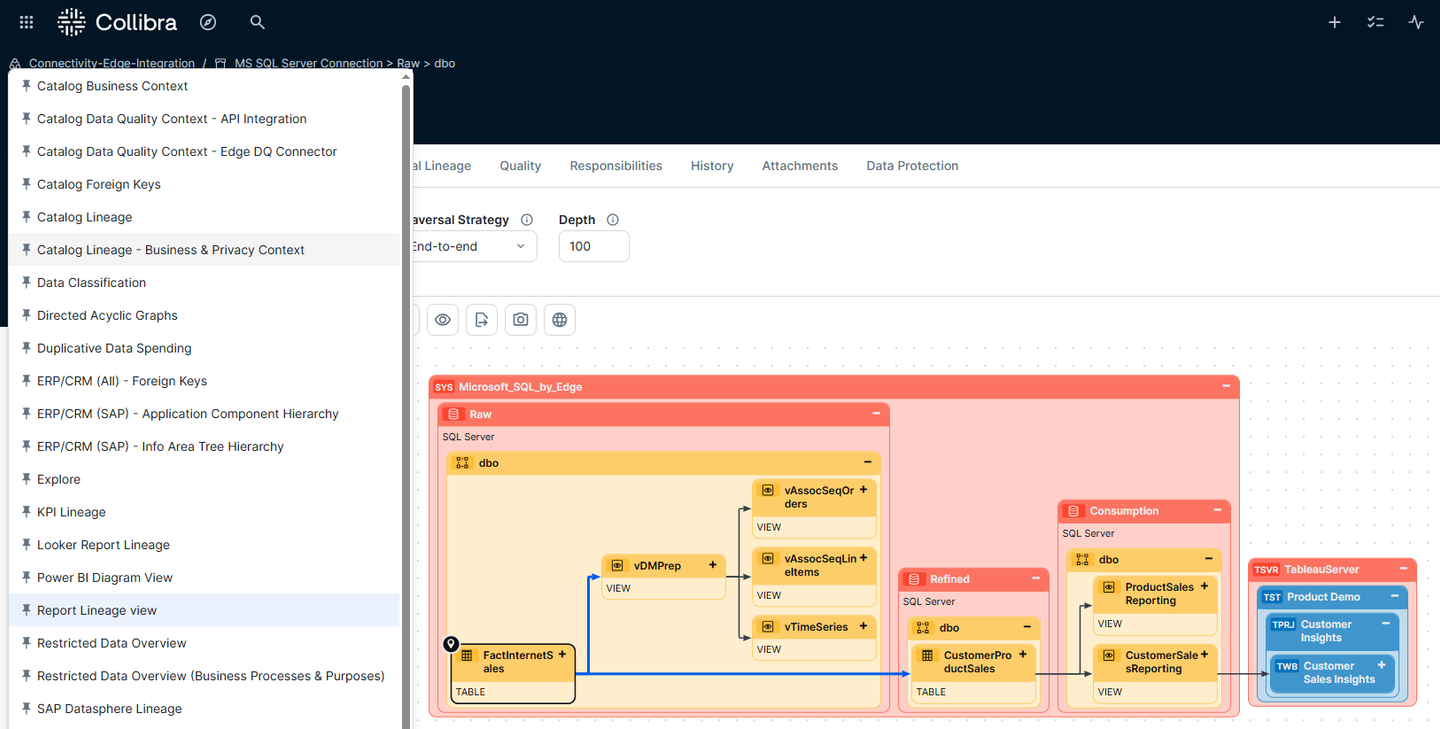
Business diagrams and views
You can also use the Technical Lineage tab to view the lineage diagram. The technical lineage diagram enables you to traverse the end-to-end flow of data from source to consumption. At any point in the lineage graph you can right-click and examine in coming and out going transformations at that specific node. The right-click menu also enables you to switch between table and column level lineage in the graph. This ability to traverse lineage end-to-end and view transformation code in context to the lineage relationships helps you better perform root cause and impact analysis.
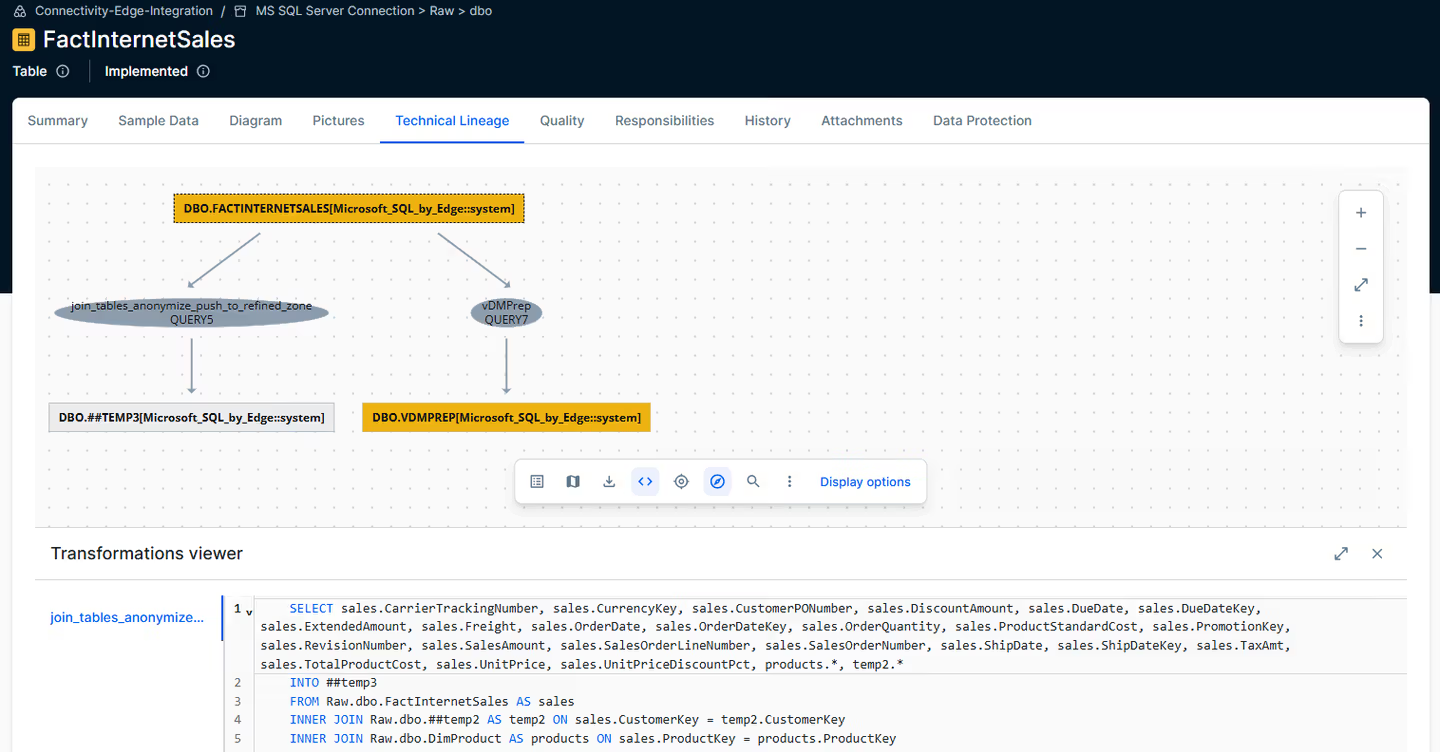
Data lineage transformation view
Why you should be excited
Data lineage helps provide visibility to the entire organization:
For data engineers and architects:
- Impact analysis and change management: Understand how system changes affect upstream and downstream processes and reports to enable proactive planning and prevent disruptions.
- Data quality management: Trace data errors to their source for faster troubleshooting and improved data reliability.
- AI development and governance: Track data lineage for AI model inputs to verify quality, identify biases and ensure the integrity of AI initiatives.
For CDOs and data governance leads:
- Regulatory compliance and auditing: Provide auditors with traceable records of data flows and transformations to demonstrate regulatory adherence and reduce compliance risks.
- Impact analysis and change management: Assess the organizational impact of data system changes to improve communication and team alignment.
- AI development and governance: Govern AI models and their data according to ethical standards and regulatory requirements to support responsible AI adoption.
For AI/ML practitioners:
- AI development and governance: Trace the full data journey for model training and deployment to ensure transparency, validate data quality and identify biases. This supports explainability and builds trust in AI outputs.
- Data quality management: Diagnose and resolve data issues quickly to maintain accurate and reliable data for optimal model performance.
- Impact analysis and change management: Assess how changes to data sources or transformations affect AI model performance and outputs.
For security, compliance and legal teams:
- Regulatory compliance and auditing: Demonstrate adherence to security protocols and data handling regulations with auditable data lineage trails for sensitive information.
- Impact analysis and change management: Assess downstream effects of data system changes on security controls and compliance requirements to prevent breaches during updates.
- AI development and governance: Monitor data used in AI systems to ensure compliance with security policies, prevent misuse, and align AI governance with legal frameworks.
Key use cases
Collibra Data Lineage provides comprehensive visibility into your data’s journey through:
Impact analysis and change management: Data Lineage maps the complete data journey, from source to destination, including all transformations. Teams can use this information to identify downstream reports, models and systems affected by changes, preventing disruptions, data quality problems and AI and analytics issues. This enables proactive planning and ensures smoother transitions during system migrations or process modifications.
Data quality management: Data Lineage offers full transparency into the data lifecycle. It enables rapid root cause analysis by identifying the exact step where a data quality issue originated. It also allows for proactive notification of stakeholders affected downstream. This accelerates troubleshooting, resolves errors faster, and enhances overall data integrity and reliability.
AI development and governance: Transparent, traceable and governed data is critical for creating reliable, unbiased and compliant AI models. Data lineage provides end-to-end visibility into the origin, transformations and usage of data in AI systems. Teams can trace training dataset sources, validate data quality in production and demonstrate regulatory controls. This enhances transparency, explainability and ensures model accuracy, fairness, and compliance.
Regulatory compliance and auditing: Data Lineage offers a verifiable record of how data is created, processed and used across the organization. It provides auditors and regulators with evidence of operational controls to ensure compliance with AI, privacy and other regulations. This auditable lineage trail reduces risk and demonstrates oversight readiness.
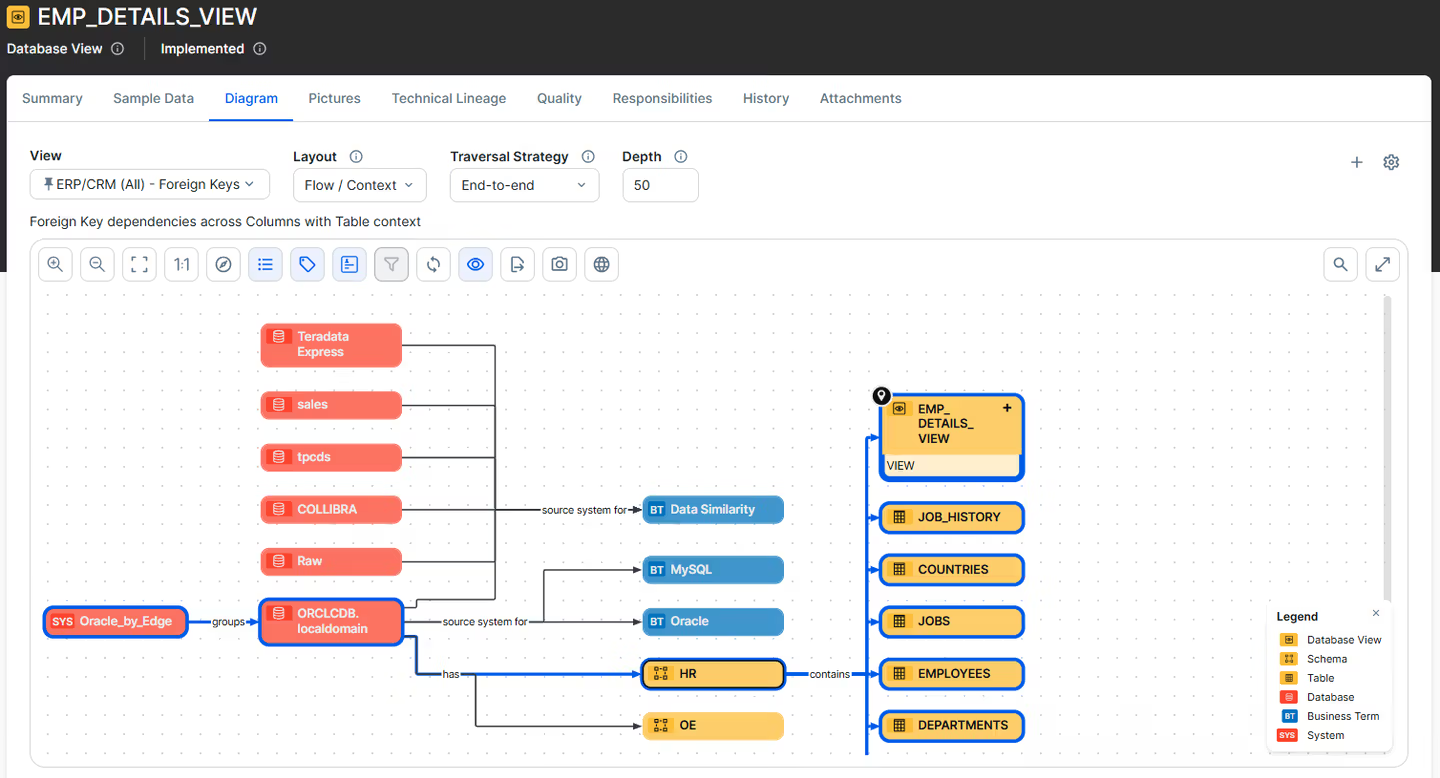
Foreign Key dependencies for employee data
Key takeaways about Collibra Data Lineage
Collibra Data Lineage gives everyone, everywhere the visibility they need to govern data with confidence. It helps you efficiently scale lineage across all your systems and tools by automatically extracting metadata, parsing lineage and stitching it to cataloged assets. With this release, Collibra Platform Self-Hosted customers gain fast and broad lineage coverage, along with improved visibility into how data is moved, transformed and used.
Join Collibra’s Product Premiere to learn how this release helps users:
- Simplify impact analysis and change management: Identify downstream dependencies before deployment and notify owners automatically.
- Increase data quality and observability: Trace anomalies to their source and view freshness and quality context at the point of use.
- Accelerate AI development and governance: Connect data, features, and models to ensure explainability and reproducibility.
- Streamline regulatory compliance and auditing: Show data provenance, flow and usage; view transformation code; and provide evidence of control design and operation.
Where to learn more about Collibra Data Lineage
For information on Collibra Data Lineage see the documentation.
Keep up with the latest from Collibra
I would like to get updates about the latest Collibra content, events and more.
Thanks for signing up
You'll begin receiving educational materials and invitations to network with our community soon.
